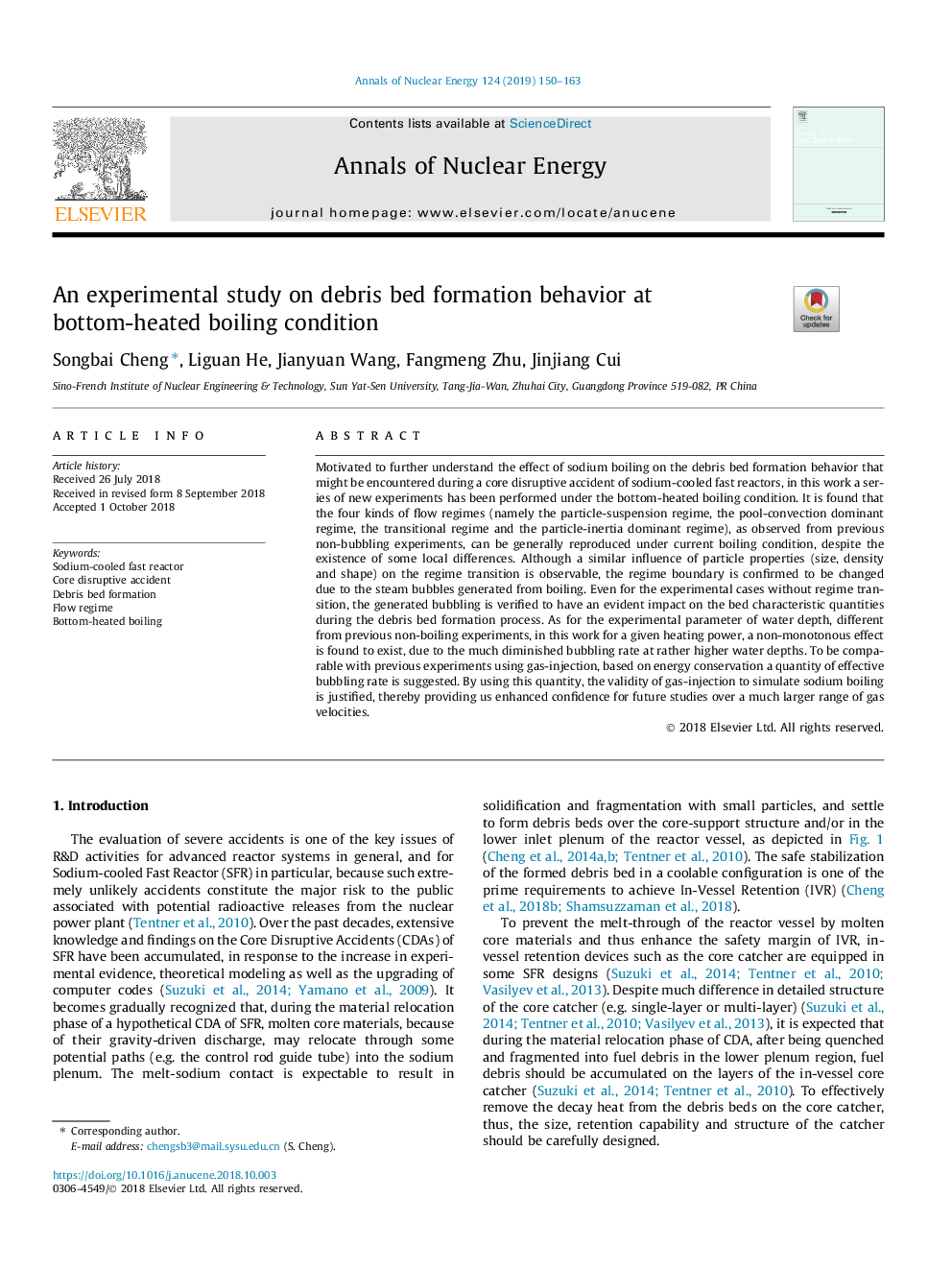| کد مقاله | کد نشریه | سال انتشار | مقاله انگلیسی | نسخه تمام متن |
|---|---|---|---|---|
| 11019771 | 1717620 | 2019 | 14 صفحه PDF | دانلود رایگان |
عنوان انگلیسی مقاله ISI
An experimental study on debris bed formation behavior at bottom-heated boiling condition
ترجمه فارسی عنوان
یک مطالعه تجربی بر روی رفتار شکل گیری بستر باقی مانده در شرایط جوش با حرارت پایین
دانلود مقاله + سفارش ترجمه
دانلود مقاله ISI انگلیسی
رایگان برای ایرانیان
کلمات کلیدی
راکتور سریع سدیم خنک، تصادف متلاشی کننده هسته، تشکیل بستر بقایای، رژیم جریان، جوش حرارتی پایین،
ترجمه چکیده
انگیزه بیشتری برای درک اثر جوش سدیم بر رفتار تشکیل رسوبات باقی مانده که ممکن است در طی یک حادثه متضاد هسته ای راکتورهای سریع سدیم سرد اتفاق بیافتد، در این کار یک سری آزمایش های جدید تحت شرایط جوش گرم به دست آمده است. مشخص شده است که چهار نوع رژیم جریان (یعنی رژیم تعلیق ذرات، رژیم غالب با استخر، رژیم انتقالی و رژیم سلطه ذرات ذره ای)، همانطور که از آزمایش های غیر غربالگری قبلی مشاهده می شود، می تواند به طور کلی بازتولید شود تحت شرایط جوی جاری، علیرغم وجود برخی تفاوت های محلی. اگر چه تاثیر شبیه خواص ذرات (اندازه، تراکم و شکل) در انتقال رژیم قابل مشاهده است، اما مرز رژیم با توجه به حباب های بخار تولید شده از جوش تغییر می کند. حتی برای موارد تجربی بدون تغییر رژیم، حباب سازی تولید شده تأثیر قابل توجهی بر مقدار مشخصه تخت در طی فرآیند تشکیل بستر بقای دارد. همانطور که برای پارامتر آزمایشی عمق آب، متفاوت از آزمایش های غرقاب قبلی، در این کار برای یک نیروی گرمای داده شده، به دلیل نرخ ببلنجی بسیار کم در عمق آب نسبتا بالاتر، یک اثر غیرمنتظره وجود دارد. برای مقابله با آزمایش های قبلی با استفاده از تزریق گاز، بر اساس صرفه جویی در انرژی، میزان باران موثر موثر پیشنهاد شده است. با استفاده از این مقدار، اعتبار تزریق گاز برای شبیه سازی جوش سدیم توجیه شده است، در نتیجه به ما اطمینان بیشتری برای مطالعات آینده در محدوده وسیع تر سرعت گاز ارائه می دهیم.
موضوعات مرتبط
مهندسی و علوم پایه
مهندسی انرژی
مهندسی انرژی و فناوری های برق
چکیده انگلیسی
Motivated to further understand the effect of sodium boiling on the debris bed formation behavior that might be encountered during a core disruptive accident of sodium-cooled fast reactors, in this work a series of new experiments has been performed under the bottom-heated boiling condition. It is found that the four kinds of flow regimes (namely the particle-suspension regime, the pool-convection dominant regime, the transitional regime and the particle-inertia dominant regime), as observed from previous non-bubbling experiments, can be generally reproduced under current boiling condition, despite the existence of some local differences. Although a similar influence of particle properties (size, density and shape) on the regime transition is observable, the regime boundary is confirmed to be changed due to the steam bubbles generated from boiling. Even for the experimental cases without regime transition, the generated bubbling is verified to have an evident impact on the bed characteristic quantities during the debris bed formation process. As for the experimental parameter of water depth, different from previous non-boiling experiments, in this work for a given heating power, a non-monotonous effect is found to exist, due to the much diminished bubbling rate at rather higher water depths. To be comparable with previous experiments using gas-injection, based on energy conservation a quantity of effective bubbling rate is suggested. By using this quantity, the validity of gas-injection to simulate sodium boiling is justified, thereby providing us enhanced confidence for future studies over a much larger range of gas velocities.
ناشر
Database: Elsevier - ScienceDirect (ساینس دایرکت)
Journal: Annals of Nuclear Energy - Volume 124, February 2019, Pages 150-163
Journal: Annals of Nuclear Energy - Volume 124, February 2019, Pages 150-163
نویسندگان
Songbai Cheng, Liguan He, Jianyuan Wang, Fangmeng Zhu, Jinjiang Cui,
